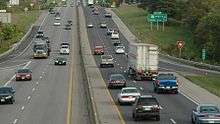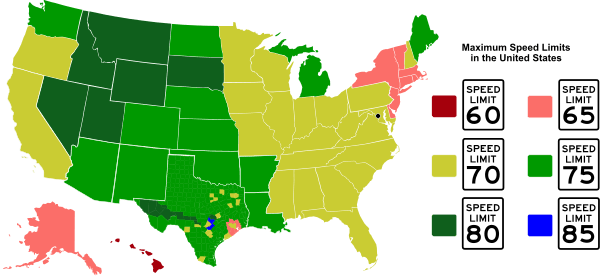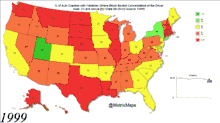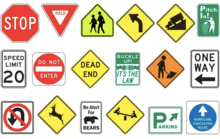Driving in the United States

Driving in the United States is a frequent occurrence, with the majority of Americans using private automobiles as their primary form of transportation to their workplace. Each state has the authority to set its own traffic laws and issue driving licenses, although these laws are largely the same and licenses from other states are respected throughout the country. Americans drive on the right side of the road. There are numerous regulations on driving behavior, including speed limits, passing regulations, and seat belt requirements. Driving while intoxicated with alcohol is a crime.
Cultural context
It is not uncommon for Americans to drive more than an hour each way to work, and 77% of Americans drive alone to their workplace, while an additional 11% carpool.
The rules of the road
Although each state sets its own traffic laws, most laws are the same or similar throughout the country. Traffic is required to keep to the right, known as a right-hand traffic pattern. The exception is the US Virgin Islands, where people drive on the left.[1]
Speed limits

Speed limits are a hotly contested issue in the United States, with many arguing that limits are set too low whilst others are arguing that limits are set too high. Despite this, most drivers exceed the speed limit by 5–15 mph (8–24 km/h) if the area appears to be free of police presence. The maximum speed limit on rural two-lane roads ranges from 50 mph (80 km/h) in parts of the northeast to 75 mph (120 km/h) in parts of Texas. On rural Interstate Highways, the speed limit ranges from 60 mph (96 km/h) in Hawaii to 85 mph (136 km/h) in parts of Texas. All roads in the United States have a speed limit, but it is not always posted frequently (especially in rural areas).
Lane discipline and overtaking
Overtaking, usually called "passing", is legal on all four or more lane roads and on most two-lane roads with sufficient sight distance. On two-lane roads, one must pass to the left of the overtaken vehicle unless that vehicle is preparing to make a left turn, in which case the vehicle must be passed on the right. Passing on the left means that the overtaking vehicle must enter the oncoming lane. This should only be done in a legal passing zone, designated by either a dashed yellow centerline (indicating that passing is legal in both directions) or a solid line paired with a dashed line (indicating that passing is only legal for traffic adjacent to the broken line). A solid double yellow line indicated that passing is illegal in both directions. In some states, it is not against the law to overtake vehicles in the presence of solid yellow lines if it is safe to do so. For example, Vermont state law also allows passing across the double yellow line when no traffic is on the opposing side; however, one must pass quickly and return to the proper side.[2] However, this is unusual as most states have a ban on crossing a double yellow line except when turning, or when pedestrians, bicycles, or other obstructions in the road make it necessary. Overtaking another vehicle across a solid yellow line is usually considered a serious traffic violation in most states.[2]

On roads with four or more lanes (including divided highways), vehicles may pass to the left or to the right of slower vehicles as long as the maneuver can be completed safely. However, most states either suggest or require that through traffic stay to the right except to pass.[3] The Manual on Uniform Traffic Control Devices includes several signage standards to inform drivers of proper lane discipline, including the "STAY RIGHT PASS LEFT" and "SLOWER TRAFFIC KEEP RIGHT" signs.[4]
Seat belt use
Seat belt legislation is another hotly contested issue, as many drivers feel that their rights are violated by such laws. Despite this, 49 states and the District of Columbia have passed laws requiring seat belt use by at least all occupants of the front seat. New Hampshire is the only state with no such requirement for adults (anyone under eighteen must use a seat belt). The majority of states do not require rear seat occupants to wear seat belts, but it would be wise to check each individual state's law. In 24 states, the seat belt law is considered to be only a secondary offense, meaning that a police officer can only ticket a person for violating the seat belt law if the driver has already been stopped for another reason. The effectiveness of seat belt laws varies considerably throughout the country, with some areas observing over 95% usage and others with less than 40% usage.
Common Car Crash & Death
It is not only drinking but also other factors causing car crashes and death. They are distraction-related deaths, drowsy-driving deaths, drunk-driving deaths, speeding-related deaths, unbelted deaths, motorcyclist deaths, pedestrian deaths, and bicyclist deaths.[5]
Drunk driving

Drunk driving is the act of operating and/or driving a motor vehicle while under the influence of alcohol and/or drugs to the degree that mental and motor skills are impaired. It is illegal in all jurisdictions within the U.S. The specific criminal offense is usually called driving under the influence [of alcohol and/or other drugs] (DUI), and in some states driving while intoxicated (DWI), operating while impaired (OWI), or operating a vehicle under the influence (OVI). Such laws may also apply to boating or piloting aircraft. Vehicles can include farm machinery and horse-drawn carriages.
In the United States, the National Highway Traffic Safety Administration (NHTSA) estimates that 17,941 people died in 2006 in alcohol-related collisions, representing 40% of total traffic deaths in the United States. NHTSA states 275,000 were injured in alcohol-related accidents in 2003.[6] The Bureau of Justice Statistics estimated that in 1996, local law enforcement agencies made 1,467,300 arrests nationwide for driving under the influence of alcohol, compared to 1,900,000 such arrests during the peak year in 1983.[7] The arrest rate for alcohol-related offenses among American Indians was more than double that for the total population during 1996, and almost 4 in 10 American Indians held in local jails had been charged with a public order offense, most commonly driving while intoxicated.[8] In 1997, an estimated 513,200 DWI offenders were under correctional supervision, down from 593,000 in 1990 and up from 270,100 in 1986.[9] The most at risk are the younger people. In 2015, drivers with a BAC of 0.08% or higher are involved in a fatal crash; three in 10 were between 21 and 24 years old (28%).[10]
NHTSA defines fatal collisions as "alcohol-related" if they believe the driver, a passenger, or non-motorist (such as a pedestrian or pedal cyclist) had a blood alcohol content (BAC) of 0.01 or greater. NHTSA defines nonfatal collisions as alcohol-related if the accident report indicates evidence of alcohol present. NHTSA specifically notes that alcohol-related does not necessarily mean a driver or non occupant was tested for alcohol and that the term does not indicate a collision or fatality was caused by the presence of alcohol.[11] On average, about 60% of the BAC values are missing or unknown. To analyze what they believe is the complete data, statisticians simulate BAC information.[12] Drivers with a BAC of 0.10 are 6 to 12 times more likely to get into a fatal crash or injury than drivers with no alcohol.[13]
Driver's license
A driving license, typically called a "driver's license", is required to operate a motor vehicle on any public road in the United States. This license is issued by the authority of individual states (including Washington, D.C. and all territories). Drivers are normally required to obtain a license from their state of residence, and all states recognize each other's licenses for temporary visitors subject to normal age requirements. Most states allow people to drive unaccompanied once they have reached the age of sixteen. A state may suspend an individual's driving privilege within its borders for traffic violations. Many states share a common system of license classes, with some exceptions, and commercial license classes are standardized by the federal law of 49 CFR part 383.[14][15]
The effects of fuel subsidy reforms
The United States has critical issues of traffic congestion and greenhouse gas emission due to driving cars. As one of the ways to solve this issue, the fuel subsidy reforms can be effective. For example, Indonesia has proved serious traffic jams based on traffic data from 19 Indonesian toll roads from 2008–2015. In order to ease the heavy traffic, the effects of fuel subsidy reforms on a motor vehicle on toll roads were investigated. Utilizing the monthly data of reforms, the estimate suggested an immediate fuel price elasticity of vehicle flows on the toll roads. The fuel subsidy reforms between 2013 and 2014 had reduced Indonesian traffic pressure on the toll roads and another 10% of traffic pressure had been cut in 2015. Reformed cost of gasoline and diesel and toll road system would contribute to smooth flow of traffic and generate for the infrastructure. Therefore, the fuel subsidy reforms should be also conducted in the United States in order to reduce traffic congestion on free-way and greenhouse gas emission.[16]
Meaning of Sign

To convey the message immediately, the roadway signs in the US use symbols rather than words. The use of symbols is not bothered by any language barriers, and can be instant communication for drivers and pedestrians in order to manage the transportation and the traffic safety. According to Federal Highway Administration, it states “the color of roadway signs is an important indicator of the information they contain. The use of red on signs is limited to stop, yield, and prohibition signs. A white background indicates a regulatory sign; yellow conveys a general warning message; green shows permitted traffic movements or directional guidance; fluorescent yellow/green indicates pedestrian crossings and school zones; orange is used for warning and guidance in roadway work zones; coral is used for incident management signs; blue indicates road user services, tourist information, and evacuation routes; and brown is for guidance to sites of public recreation or cultural interest. Sign shape can also alert roadway users to the type of information displayed on a sign. Traffic regulations are conveyed in signs that are rectangular with the longer direction vertical or square. Additional regulatory signs are octagons for stop and inverted triangles for yield. Diamond-shaped signs signify warnings. Rectangular signs with the longer direction horizontal provide guidance information. Pentagons indicate school zones. A circular sign warns of a railroad crossing." [17]
Environmental impact of Driving vehicles
Eco-driving has featured reduction of CO2 emission reduction and revealed to lead one of best climate change strategies. The investigation of Eco-driving is consistent with the assessment of accelerating and decelerating under varying traffic and environmental volume and composition. Using micro-simulation, they analyzed the effects of Eco-Driving on network-wide traffic and environmental performance at the speed of 30 km/h. It shows that increasing uses of Eco-Driving in certain road networks significantly affect a cause of traffic congestion and heavy traffic at the investigated roads. As a result, it causes an increase in CO2 emissions of up to 18%. Using Eco-Driving under limited speed and control of acceleration and deceleration can possibly affect CO2 emissions.[18]
Several pollutants can be made by car-driving such as carbon dioxide, carbon monoxide, sulfur oxides, nitrogen oxides, hydrocarbon, and lead. They pollute the environment and affect human health. Carbon dioxide is the dominant greenhouse gas that is one of the causes of global warming. It includes flooding, droughts, storms, and disruption of the ecosystem. Carbon monoxide implores the flow of oxygen in the blood to the brain and other body parts. It affects people with heart disease and the central nervous system. Sulfur oxides are the cause of acid rain that damages the nature and human health. It particularly aggravates heart and lung diseases in children and the elderly. Nitrogen oxides are the main ingredients in the formation of acid rain and ground-level ozone that contributes to the global warming. Hydrocarbons are pollutants of air toxics and hazardous to the lung and other body parts. It causes cancer and birth defects. Finally, high-lead level in the air can damage organs and affect the blood, nerves, brains, and heart. The urban areas relatively have higher traffic density, so they tend to have a higher lead level and more risk to health.[19]
See also
References
| Wikivoyage has travel information for driving in the United States. |
- ↑ "Driving Tips & Rules for Easy Car Rental in USA". Usacarsrental.com. Retrieved 2017-07-27.
- 1 2 "AGENCY OF TRANSPORTATION : Department of Motor Vehicles". Dmv.vermont.gov. Retrieved 2017-07-27.
- ↑ "State "keep right" laws". Mit.edu. Retrieved 2017-07-27.
- ↑ "Manual on Uniform Traffic Control Devices" (PDF). Mutcd.fhwa.dot.gov. 2009. Retrieved 2017-07-27.
- ↑ vi.chilukuri.ctr@dot.gov (2017-10-06). "USDOT Releases 2016 Fatal Traffic Crash Data". NHTSA. Retrieved 2018-04-13.
- ↑ DOT HS 809775, a.k.a. Traffic Safety Facts 2003
- ↑ Four in Ten Criminal Offenders Report Alcohol as a Factor in Violence: But Alcohol-Related Deaths and Consumption in Decline, April 5, 1998, United States Bureau of Justice Statistics
- ↑ American Indians are Violent Crime Victims at Double the Rate of General Population, February 19, 1999, United States Bureau of Justice Statistics
- ↑ DWI Offenders under Correctional Supervision, June 1999, United States Bureau of Justice Statistics
- ↑ "Impaired Driving: Get the Facts | Motor Vehicle Safety | CDC Injury Center". www.cdc.gov. 2018-02-21. Retrieved 2018-04-13.
- ↑ "Archived copy" (PDF). Archived from the original (PDF) on 2011-07-21. Retrieved 2011-03-13.
- ↑ Subramanian, Rajesh (2002), Transitioning to Multiple Imputation: A New Method to Impute Missing Blood Alcohol Concentration (BAC) values in FARS, National Highway Traffic Safety Administration, DOT HS 809 403, retrieved 27 February 2018
- ↑ Jones, R.K; Lacey, J.H. (2001). "Overview of the Alcohol-Crash Problem". Alcohol and Highway Safety 2001: A Review of the State of Knowledge. National Highway Traffic Safety Administration / Mid-America Research. DOT HS 809 383. Retrieved 27 February 2018.
- ↑ "Search Regulations | Federal Motor Carrier Safety Administration". Fmcsa.dot.gov. Retrieved 2017-07-27.
- ↑ Archived 2011-07-21 at the Wayback Machine.
- ↑ Burke, Paul; Batsuuri, Tsendsuren; Yudhistira, Muhammad Halley (2017). "Easing the traffic: The effects of Indonesia's fuel subsidy reforms on toll-road travel". Transportation Research Part A. 105: 167–180. doi:10.1016/j.tra.2017.08.003. ISSN 0965-8564.
- ↑ "United States Road Symbol Signs".
- ↑ Alam, Md. Saniul; McNabola, Aonghus (2018). "Network-wide traffic and environmental impacts of acceleration and deceleration among Eco-Driving Vehicles in different road configurations". Transportation Planning and Technology. 41 (3): 244–264. doi:10.1080/03081060.2018.1435436. ISSN 0308-1060.
- ↑ "Protect the Environment: On the Road".